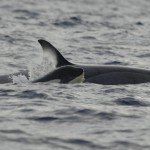Today brought us into contact with our first killer whales (Orcinus orca) of the trip. Ari spotted them traveling northeast along the Gerlache, and thanks to a little luck, he soon had some amazing pictures of them.
It will no doubt surprise you – the reader of this blog – that the last 24 hours have yet again been full of new and exciting things for us down here in Antarctica. First and foremost, I have to report that we are getting some serious work done out here. As of this morning, we’ve deployed and recovered our 7th DTAG and now have over 80 hours of data documenting the fine-scale movements and foraging behavior of humpback whales in the Western Antarctic Peninsula. The tag that was put on yesterday peeled off the whale sometime in the EARLY hours of the day here – about 7:42am. I have to be careful using the word “day”, as it doesn’t really get light until after 9:00am now. The tagged whale had spent its entire night in a small cove at the end of Andvord Bay, making it relatively easy for the radio-tracking team to keep it in range.
- Killer Whales
In fact, the radio-tracking was the easy part last night. The really difficult thing was keeping the LMG, a relatively large and stout ice-strengthened oceanographic vessel, safely in the center of a narrow fjord in the face of catabatic winds gusting to 50kts. On my shift – 2-4am – Ernest was at the helm, and he did an amazing job keeping the Gould in one place, and actually pointed in the direction we wanted while tracking the whale. On occasion the wind gusts would heel the ship over more than just a few degrees, and rapidly start to drag the bow of the ship off heading. Ernest would calmly correct the spin and bring us back to where we needed to be. Oh yeah, and at the same time he also was dodging the large growlers and small icebergs that were being carried down the bay towards us by the gusting winds – in the dark. I actually can’t say enough about how professional and skilled the crew of the LMG is. They calmly navigate this giant ship into places that I’d be nervous taking a small boat into.
Today also brought us into contact with our first killer whales (Orcinus orca) of the trip. Ari spotted them traveling northeast along the Gerlache, and thanks to a little luck, he soon had some amazing pictures of them. After close inspection, we’ve identified them as Type B killer whales – the large white eyepatch and clearly distinct black dorsal cape were the deciding factors as we went through the pictures. Killer whales are not well studied in the Antarctic, but it appears that there are 3 “ecotypes” found in these frigid waters. Type A killer whales appear similar to those found in other places and they tend to inhabit ice-free offshore waters, feeding on minke whales. Type B killer whales are found inshore, often in association with pack ice, and are known to patrol the waters of the central Western Antarctic Peninsula including the Gerlache Strait. This ecotype appears to feed on pinnipeds, as well as minkes and humpbacks (no shortage of them here). Type C killer whales feed mainly on fish in the inshore pack ice of the East Antarctic.
- Killer Whales
My final observation for the blog today is about how interesting and compelling some of our pole camera footage is turning out to be. Example 1. If you haven’t looked at the video of the leopard seal from last leg please do. And when you do, take a good look at how that seal uses it’s pectoral flippers as it swims by the boat and past the camera. If you didn’t look at the back end of that seal, and just focused on how it uses those large, wing-like flippers it would be quite easy to confuse it with a fur seal. Neat, and probably important for scarfing down penguins. Example 2. We were lucky enough to get some decent underwater footage of a humpback whale as we deployed a tag on it. It’s great to get video during these moments, as it gives us a better understanding of the condition of the animals we are tagging (this whale was incredibly fat after a good summer of chowing down on krill) and it also documents their reaction to the tagging event itself. In this case, the animal was clearly startled by the application of the suction cups (an expected reaction), and it swam quickly away. The most interesting thing was watching how the animal initially used its huge white pectoral flippers to “scull” itself forward as it tried to move away. The animal then flaps its pectoral flippers to continue moving forward, providing further initial momentum before the big kicks from the tail flukes take over and drive the animal into the depths. I’ll post that video on the blog from Palmer next time we are in, and will amend this entry with a link to it. When it is up, take a look. It’s definitely a good way to spend 2 minutes of your life.
Hi to my friends and family, and a big Happy Birthday to my Dad – Al Johnston – on the 19th of May!


